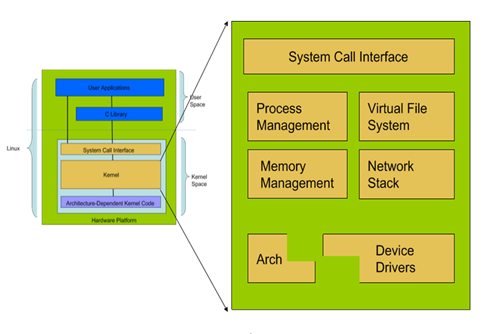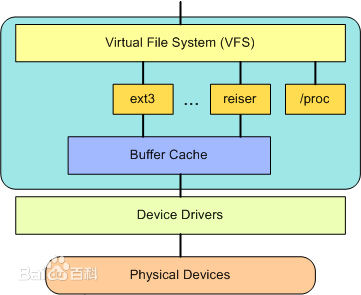Detailed explanation of Linux architecture and kernel structure
Linux Architecture
As shown in the figure below, the Linux architecture can be broadly divided into user space (User Space) and kernel space (Kernel Space).

User space includes C libraries and user applications. Some architecture diagrams also include shells. Of course, shell scripts are also an integral part of the Linux system.
The kernel space includes hardware platform, platform dependent code, kernel and system call interface.
In any modern operating system, there are layers. Why is layering necessary? From a programmer's perspective, separating the Linux underlying and applications allows each to focus on its own area, thereby improving efficiency. From a security perspective, layering is about protecting the kernel. Modern CPUs usually implement different working modes. For example, ARM implements 7 working modes. In different modes, the CPU can execute different instructions or access different registers. If all upper-layer applications can call registers at will, the operating system cannot execute stably. Therefore, a new discipline has emerged in operating systems - "modern operating systems".
In the X86 architecture, 4 different levels of permissions are implemented, namely Ring0 to Ring3. Under Ring0 permissions, privileged instructions can be executed and IO devices can be accessed, while under Ring3 permissions there are many restrictions.
Android is even more "crazy". All APK applications run on the Java virtual machine, and the applications are further away from the bottom layer.
In addition, user space and kernel space are two different states of program execution. We can complete the transfer from user space to kernel space through "system call" and "hardware interrupt".
Linux kernel structure
In this section, we analyze the kernel structure.
As shown in the figure below, it is the Linux kernel structure diagram.

SCI layer (System Call Interface), this layer provides a set of standard system call functions for application user space to access Linux. When analyzing the Linux architecture earlier, we introduced that any modern operating system will not allow upper-layer applications to directly access the lower layer. In Linux, the kernel provides a set of standard interfaces through which upper-layer applications can access. Ground floor.
PM (Procees Management), this part includes specifically creating processes (fork, exec), stopping processes (kill, exit), and controlling communication between them (signal, etc.). Also included is process scheduling, which controls how active processes share the CPU. This part is already done by Linux. When writing the driver, you only need to call the corresponding functions to realize these functions, such as creating processes, process communication, etc.
MM (Memory Management), the main function of memory management is to control the safe shared memory area of multiple processes.
VFS (Virtual File Systems), a virtual file system, hides the specific details of various file systems and provides a unified interface for file operations. In Linux, "everything is a file", and these files are implemented through VFS. Linux provides a large general model that encompasses the set of all file system functions. As shown in the figure below, it is the structure diagram of a virtual file system.

Device Drivers device driver, this part is what needs to be learned and mastered. There is a large amount of code in the Linux kernel in the device driver section, which is used to control specific hardware devices.
Linux drivers are generally divided into network devices, block devices, character devices, and miscellaneous devices. We only need to write character devices. Miscellaneous devices are a type of driver that are not easy to classify. There are many overlaps between miscellaneous devices and character devices. .
Network protocol stack, the Linux kernel provides a wealth of network protocol implementations.
Before learning Linux drivers, you need to understand and master the Linux architecture and Linux kernel structure
The above is the detailed content of Detailed explanation of Linux architecture and kernel structure. For more information, please follow other related articles on the PHP Chinese website!

Hot AI Tools

Undresser.AI Undress
AI-powered app for creating realistic nude photos

AI Clothes Remover
Online AI tool for removing clothes from photos.

Undress AI Tool
Undress images for free

Clothoff.io
AI clothes remover

AI Hentai Generator
Generate AI Hentai for free.

Hot Article

Hot Tools

Notepad++7.3.1
Easy-to-use and free code editor

SublimeText3 Chinese version
Chinese version, very easy to use

Zend Studio 13.0.1
Powerful PHP integrated development environment

Dreamweaver CS6
Visual web development tools

SublimeText3 Mac version
God-level code editing software (SublimeText3)

Hot Topics
 deepseek web version entrance deepseek official website entrance
Feb 19, 2025 pm 04:54 PM
deepseek web version entrance deepseek official website entrance
Feb 19, 2025 pm 04:54 PM
DeepSeek is a powerful intelligent search and analysis tool that provides two access methods: web version and official website. The web version is convenient and efficient, and can be used without installation; the official website provides comprehensive product information, download resources and support services. Whether individuals or corporate users, they can easily obtain and analyze massive data through DeepSeek to improve work efficiency, assist decision-making and promote innovation.
 How to install deepseek
Feb 19, 2025 pm 05:48 PM
How to install deepseek
Feb 19, 2025 pm 05:48 PM
There are many ways to install DeepSeek, including: compile from source (for experienced developers) using precompiled packages (for Windows users) using Docker containers (for most convenient, no need to worry about compatibility) No matter which method you choose, Please read the official documents carefully and prepare them fully to avoid unnecessary trouble.
 Ouyi okx installation package is directly included
Feb 21, 2025 pm 08:00 PM
Ouyi okx installation package is directly included
Feb 21, 2025 pm 08:00 PM
Ouyi OKX, the world's leading digital asset exchange, has now launched an official installation package to provide a safe and convenient trading experience. The OKX installation package of Ouyi does not need to be accessed through a browser. It can directly install independent applications on the device, creating a stable and efficient trading platform for users. The installation process is simple and easy to understand. Users only need to download the latest version of the installation package and follow the prompts to complete the installation step by step.
 BITGet official website installation (2025 beginner's guide)
Feb 21, 2025 pm 08:42 PM
BITGet official website installation (2025 beginner's guide)
Feb 21, 2025 pm 08:42 PM
BITGet is a cryptocurrency exchange that provides a variety of trading services including spot trading, contract trading and derivatives. Founded in 2018, the exchange is headquartered in Singapore and is committed to providing users with a safe and reliable trading platform. BITGet offers a variety of trading pairs, including BTC/USDT, ETH/USDT and XRP/USDT. Additionally, the exchange has a reputation for security and liquidity and offers a variety of features such as premium order types, leveraged trading and 24/7 customer support.
 Get the gate.io installation package for free
Feb 21, 2025 pm 08:21 PM
Get the gate.io installation package for free
Feb 21, 2025 pm 08:21 PM
Gate.io is a popular cryptocurrency exchange that users can use by downloading its installation package and installing it on their devices. The steps to obtain the installation package are as follows: Visit the official website of Gate.io, click "Download", select the corresponding operating system (Windows, Mac or Linux), and download the installation package to your computer. It is recommended to temporarily disable antivirus software or firewall during installation to ensure smooth installation. After completion, the user needs to create a Gate.io account to start using it.
 Ouyi Exchange Download Official Portal
Feb 21, 2025 pm 07:51 PM
Ouyi Exchange Download Official Portal
Feb 21, 2025 pm 07:51 PM
Ouyi, also known as OKX, is a world-leading cryptocurrency trading platform. The article provides a download portal for Ouyi's official installation package, which facilitates users to install Ouyi client on different devices. This installation package supports Windows, Mac, Android and iOS systems. Users can choose the corresponding version to download according to their device type. After the installation is completed, users can register or log in to the Ouyi account, start trading cryptocurrencies and enjoy other services provided by the platform.
 Why does an error occur when installing an extension using PECL in a Docker environment? How to solve it?
Apr 01, 2025 pm 03:06 PM
Why does an error occur when installing an extension using PECL in a Docker environment? How to solve it?
Apr 01, 2025 pm 03:06 PM
Causes and solutions for errors when using PECL to install extensions in Docker environment When using Docker environment, we often encounter some headaches...
 gate.io official website registration installation package link
Feb 21, 2025 pm 08:15 PM
gate.io official website registration installation package link
Feb 21, 2025 pm 08:15 PM
Gate.io is a highly acclaimed cryptocurrency trading platform known for its extensive token selection, low transaction fees and a user-friendly interface. With its advanced security features and excellent customer service, Gate.io provides traders with a reliable and convenient cryptocurrency trading environment. If you want to join Gate.io, please click the link provided to download the official registration installation package to start your cryptocurrency trading journey.






